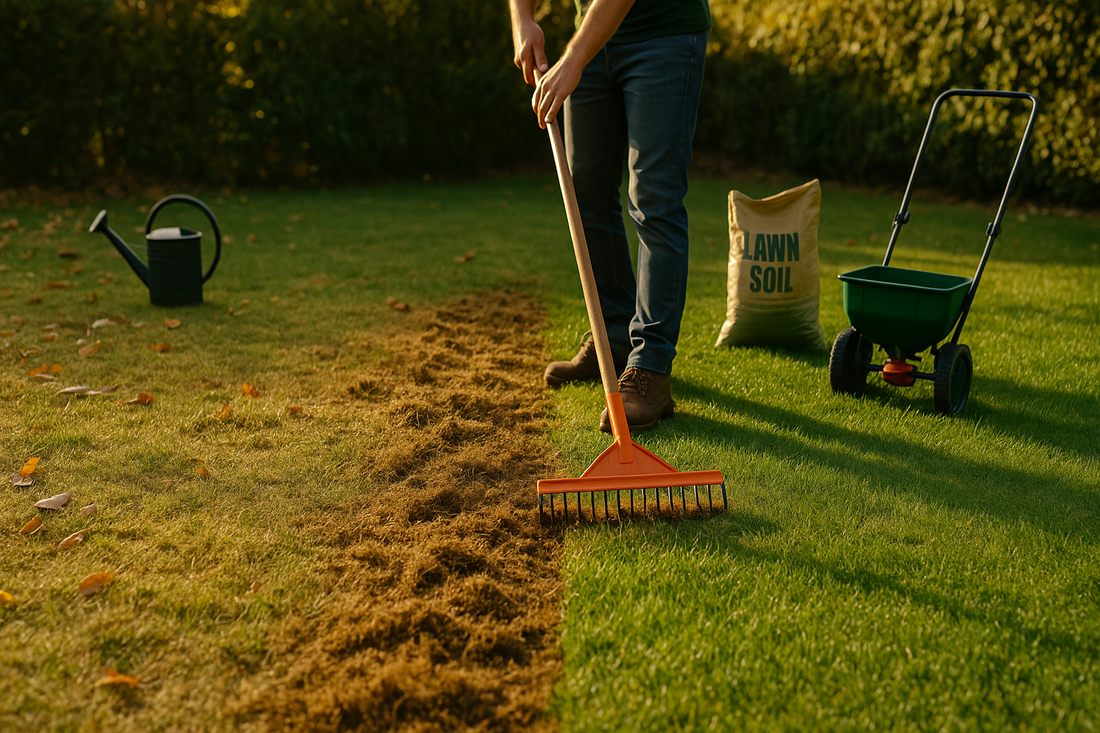
The 2-Weekend Autumn Lawn Reset
Autumn is the sweet spot for lawn rescue in the UK: warm soil, regular showers, and cooler air that helps roots, not weeds.
Give me two weekends and a little care in between, and we’ll take your lawn from tired to tidy, patchy to plush.
Before you start (1 minute)
You don’t need fancy gear. A mower, a rake (or light scarifier), grass seed for repair, a bag of autumn fertiliser, and a hose with a fine spray are enough.
Think gentle and regular, not heavy and heroic.
Weekend 1 — Clean + Seed
Saturday: The Clean-Out
Goal: open the surface so air, water, and goodness can reach the roots.
-
Mow a bit shorter than usual
Set the mower lowish (about 3–4 cm). Bag the clippings. -
Rake or lightly scarify
Use a spring-tine rake or a small scarifier to remove the brown “thatch” and any moss. Two calm passes in different directions are better than one aggressive blast.
It will look a little scruffy. That’s good. Your lawn can breathe again. -
Optional top-up
If the surface is lumpy, sift on a very thin layer of lawn topsoil/compost (a few millimetres) and brush it in. This evens things out and keeps moisture near the seed you’ll add tomorrow.
Why this matters: a clogged surface acts like a blocked filter. This clean-out is the reset button.
Sunday: The Reseed
Goal: fill the gaps so the lawn knits together.
-
Choose the right seed
Pick a repair/overseeding mix (it germinates quickly) or a blend that suits your garden: family use, ornamental, or shady areas. -
Lightly loosen the bare patches
Scratch the soil surface with a rake so the seed has somewhere to sit. -
Sow thinly and evenly
Aim for a fine sprinkle—enough to cover the soil, not bury it. If you love numbers: around 25–35 g per m². -
Dusting coat, not a duvet
Shake on a wafer-thin veil of lawn topsoil/compost to protect the seed. Don’t bury it. -
Firm and mist
Press the seed to the soil (a roller, or simply a flat board underfoot). Water with a soft spray so nothing washes away.
Why this works: seed needs soil contact and consistent moisture. That’s it. Keep it simple.
The Week Between — Gentle Habits Win
Water little and often. Think of misting a houseplant, not soaking a patio. Keep the top 1 cm of soil damp. If wind and sun dry it out, add a quick 2–3-minute spray.
Keep off the new patches. If you must cross the lawn, use stepping stones or the path edge.
Be patient. New shoots usually show in 7–14 days depending on temperature.
First new mow? Wait until the new grass reaches 8–10 cm, then cut lightly and higher than usual.
Weekend 2 — Shape + Feed
Saturday: Tidy and Check
Light, tall mow. Raise the deck to about 5–6 cm. This protects young blades and encourages thickness, not weak growth.
Top up thin spots. Any areas that still look bare? Sprinkle a little more seed and mist.
Sunday: Autumn Feed
Now we help the roots. Use an autumn lawn fertiliser (lower nitrogen, more potassium). It won’t force a fast surge of top growth; it hardens the lawn for winter and deepens the green.
- Apply exactly as the pack suggests.
- Water for a few minutes after spreading if no rain is due.
Why autumn feed matters: you’re building a tougher lawn that shrugs off frost, footfall, and fungus, and wakes up faster in spring.
What you’ll notice (and when)
- End of Week 1: the lawn looks cleaner and “freed up”.
- Mid-Week 2: fresh green hairs in patchy spots, edges look neater.
- After Weekend 2: colour deepens, texture thickens, and the lawn feels springy underfoot.
- By mid-autumn: fewer weeds get in, moss backs off, and you enter winter with a lawn that holds its own.
Simple rules that keep results coming
- Go easy: gentle passes with the rake, gentle water, gentle first mow.
- Stay a bit higher: 5–6 cm is your friend in autumn—protects crowns, shades soil, and helps density.
- Moist, not soggy: little and often wins. Puddles don’t.
- Keep feeding smart: autumn feed now; save high-nitrogen products for spring.


